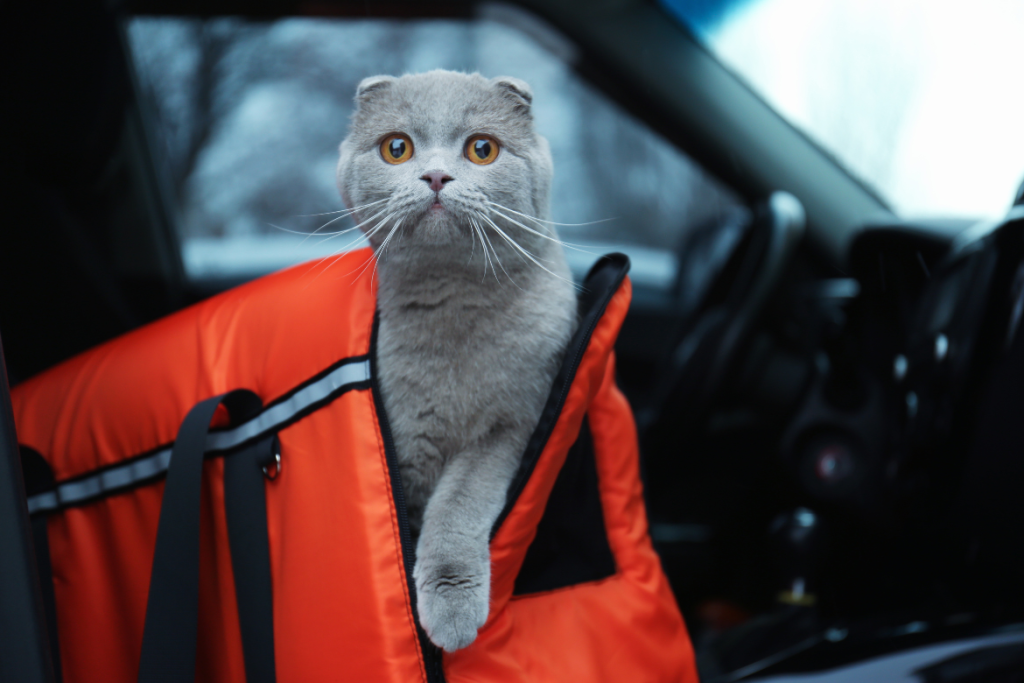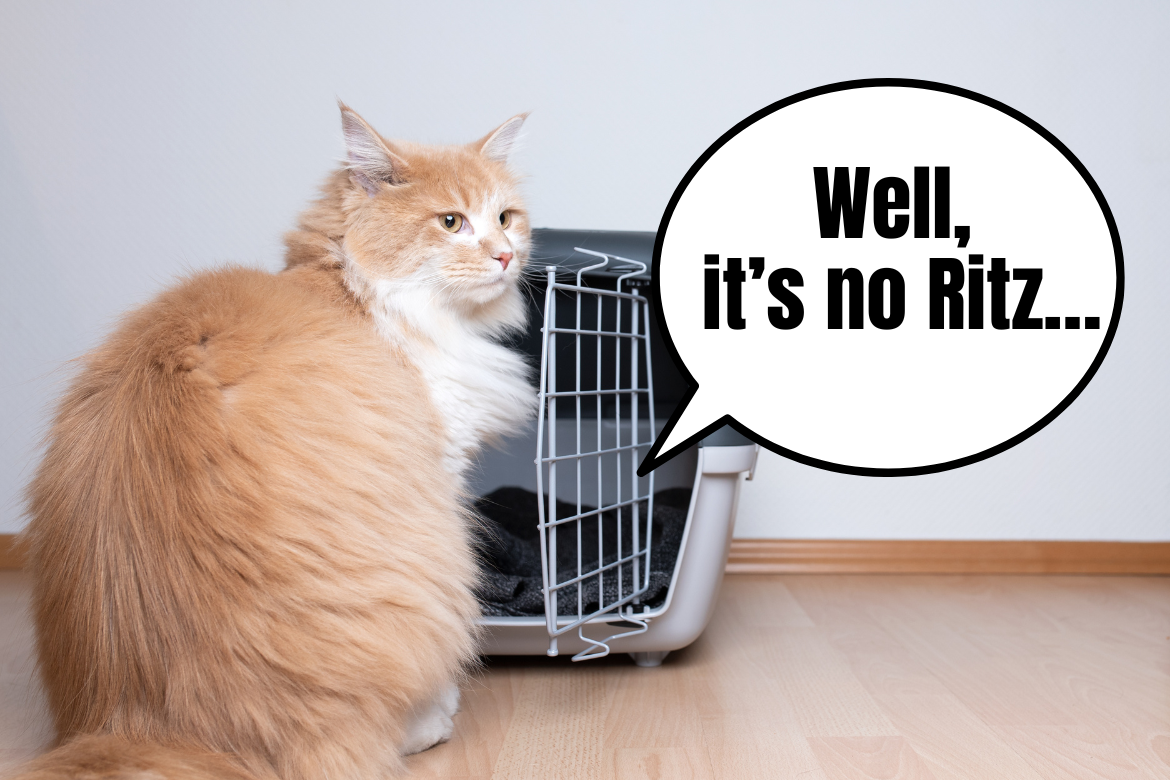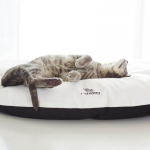Do we have any cats here who, upon seeing a carrier, don’t curl up under the bed and instead happily jump inside awaiting a trip? You surely know you’re in the minority, right? Oftentimes it’s not the carrier itself that’s the problem, but rather the context of it and we don’t need to look far for examples – our team cat Tosia uses her carrier everyday as her safe bunker but if she sees us packing our suitcases, she stays far away from it. Today, fabCats, we’re diving into the topic like a cat would into a pool of catnip – let’s see how to get a cat used to a carrier and how to choose one that will make your cat travel safely and comfortably.
Buying a cat carrier
Let’s start with the basics – choosing a carrier that will make your cat feel good. If you sometimes travel with a cat (and we know that from time to time, everyone has to fight with their cat before going to the vet), the most important criteria for choosing the right carrier should be your cat’s safety. For this reason, the best option are plastic, sturdy carriers – in case of a road accident or your cat being sick, it will be much more comfortable and safer than a soft bag or a wicker basket. And while on the topic of safety, we should also take our cat’s escaping talents into consideration – if opening up the carrier is too easy for them and happens while you’re driving, your cat could be a serious danger for themselves, the driver, the passengers and other people on the road.
You should also remember to always pick the size of a carrier according to your cat’s size – the box should not be too small or too big. Cats feel the safest in smaller, confined spaces, but they should still be able to move around easily or to stretch out during a longer trip.
The third issue you need to consider is the furnishings. Plastic carriers are hard and require a softer blanket or a pillow inside for your cat to be cozy. If you’re planning a longer trip or your cat is really stressed, think about putting down a puppy pad inside too, just in case of a smelly emergency. You should also try to make sure that the pillow or blanket you put inside smells of your cat, you or your house – it will make the cat feel at home. And to reduce stress during travels or on your way to the vet, one thing you can do is to use catnip or pheromone spray to make the carrier seem like the best place on Earth 
What other, practical solutions found in cat carriers could help your feline friend feel better?
- standard door + the possibility to open up the entire wall or to take off the roof of the carrier – it gives you easier access to the cat, e.g. during a vet visit;
- solid walls – transparent walls give your cat a great view of the outside, but if your cat is stressed seeing strangers or hearing noises, solid walls will give them a much better hideout from the outside world. A good idea as well is to put a blanket or a dedicated cover over the carrier to cut out the outside noise and let your cat chill out in their own, private haven;
- good ventilation – it’s very important during summer when even a short trip to the vet in a hot car will be difficult for a cat. In the winter you can put an extra cover or a blanket over the carrier to keep them safe from the cold;
- comfortable handles – the weight of the cat + the weight of the carrier are often an issue, especially when a stressed-out cat is moving around. When looking for a carrier, pick one that has handles that are comfortable to hold, allow you to add extra shoulder strap or, in case of heavier cats, have wheels or a backpack style that will make it easier to carry;
- option to attach a harness or a leash. If you’re getting ready for a longer trip and will be stopping on the way to let your cat out of the carrier and into a litter box or to eat and drink, being able to attach a harness or a leash to the carrier and keep your cat extra safe is key.

Why are cats scared of carriers?
While looking through discourse around the topic of cat carriers and getting cats used to traveling, one of the most common issues is cats running away as soon as they see you taking out the carrier from your closet. And that’s not surprising! Because of the way we love our home space to be arranged, available space and often questionable aesthetics of cat carriers, many Carers simply don’t keep their cat carrier out – it’s being taken out of the closet only when it’s needed. Unfortunately, cats quickly learn from their previous experiences and associate certain items and our actions with a particular event from the past.
“If getting into the carrier meant landing in a vet office the last time, I’m not risking going in right now.”
To make matters worse, going to the vet is usually a quick thing – before we leave for the visit, we don’t have time to set up the carrier in the middle of the room and convince our cats to get inside with their favorite treats while they are already hiding under the bed and don’t think of leaving any time soon. How does it all end? The cat is being taken out from under the bed by force, put into the carrier and taken to the vet in a rush. This scenario puts even more trauma into the experience of being in a carrier. No wonder cats see it as if it’s the devil.

Traveling 101 – how to get a cat used to a carrier?
Okay, fabCat – now that you know why your cat might be hesitant to go into their carrier, what could you do to change the situation? Work, work, work on it. Without working with your cat on positive reinforcement and associating the carrier with good things, the 5-minute chase around the house before every vet visit is inevitable. It’s time we give you a few of our tried and true tricks of working with getting a cat used to a carrier.
Build up happy memories. Don’t let the carrier become a mysterious, scary cage that teleports an innocent kitty into a noisy car and then a vet’s office. From the first day your cat’s at home or the first hours after you buy the carrier, work on making the carrier seem like a friendly place – good for playing, getting treats and food, or napping. You can use clicker training for it or simply give out snacks – place the carrier in the middle of the room and reward your cat for interacting with it, getting inside, sitting inside, and even letting you close it for a moment without panicking.
More about clicker training on our blog: https://blog.mykotty.pl/2022/09/26/na-czym-polega-trening-z-klikerem/
Remember: The more regular your training is, the better the chance for a) success and b) keeping the success streak going for a long time. Don’t stop training with your cat when it seems like they’re accepting the carrier. One stressful trip is enough to make them feel like they can’t trust the carrier in your hands again.
Make the carrier available at all times. As fans of minimalist interior design and beautiful spaces, we know that setting up a cat carrier to be seen at all times is not the best decorative choice. However, there’s a strong correlation between cats having their carrier accessible at all times and tolerating it. Cats that use the carrier as their sleeping hub every day are less hesitant to get inside when a situation calls for it. There are exceptions, of course, one being our team cat Tosia, but even she gets calm once we put her inside the carrier and travels quietly with us, staying inside the carrier once we arrive wherever we’re going.
Availability of the carrier eliminates the distance between the cat and their cage – your cat won’t see it as a new, mysterious thing every time but rather accept it as their own space, soaked with their own scent and the remnants of their previous, cozy nap.
Be spontaneous. Training with a carrier is easiest when we leave some space for being spontaneous. Work with your cat in the morning, mid-day, and in the evenings, on a random Saturday and the day before your planned trip to the vet. Place the carrier in the middle of your living room and in a quiet space in the bedroom. Reward your cat for sleeping inside, but don’t be scared to lift up the carrier when your cat is observing you and place it somewhere else (as if you were to actually take the cat somewhere). By doing it like that you show your cat that, regardless of the circumstances, your behavior, time of the day, or day of the week, getting into a carrier is safe and brings rewards. The more variety there is in your training program, the better the chance that your cat won’t be associating the carrier with good things only in very particular circumstances.
And what about cats whose aversion to the carrier is on such a level that no attempts of training bring you any success? There are two things you can do: buy a new carrier, one that looks completely different from the one you have, and start training with the new one from scratch, or, what we recommend for especially stubborn kitties, consult your problem with a behaviorist. A specialist will not only show you which parts of your training need improvement but they will also try to understand your cat, their fears and needs, as well as your lifestyle and find a solution that works for you.
And now, going back to a question for you, fabCats – how do your cats get along with their carriers? Is jumping in a piece of cake or maybe they immediately retreat into the furthest corner of the bedroom as soon as they see you pick the carrier up?




